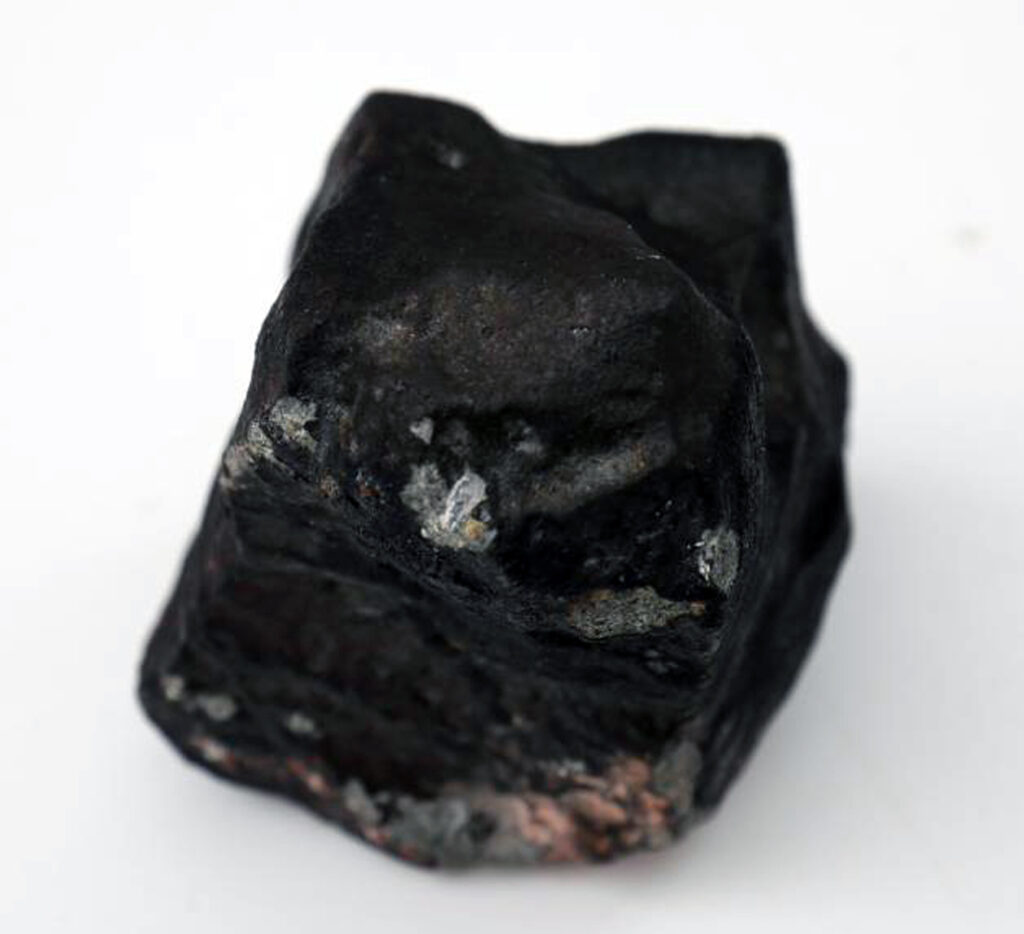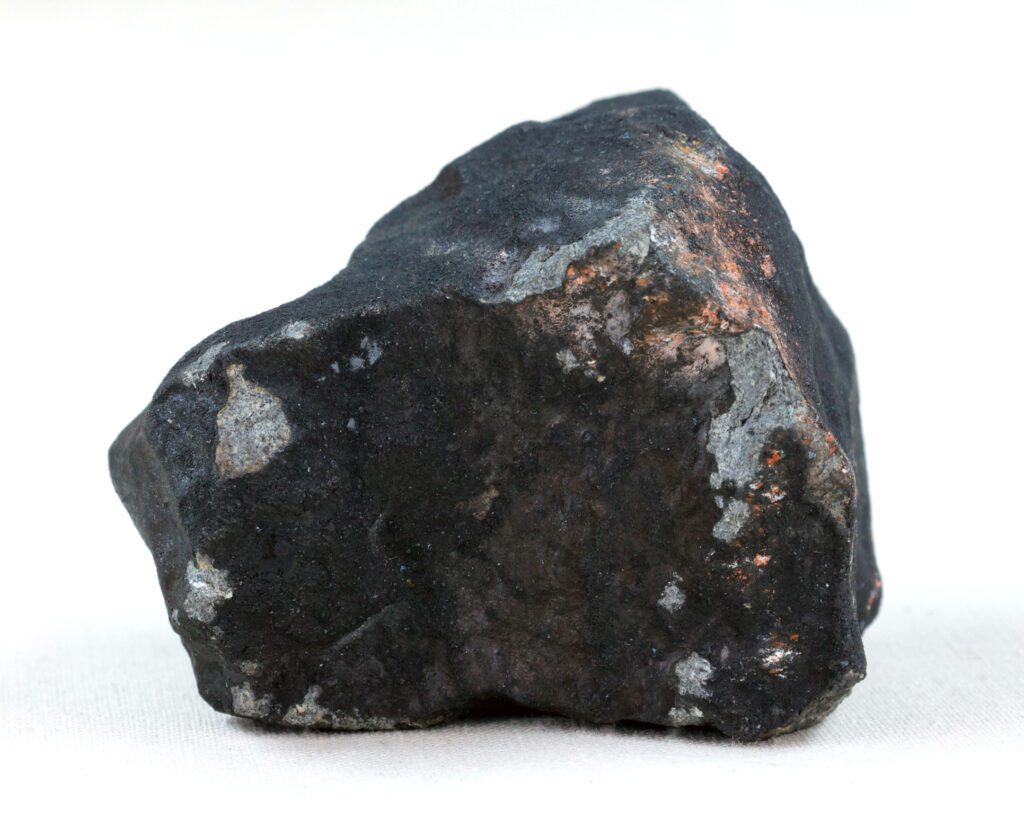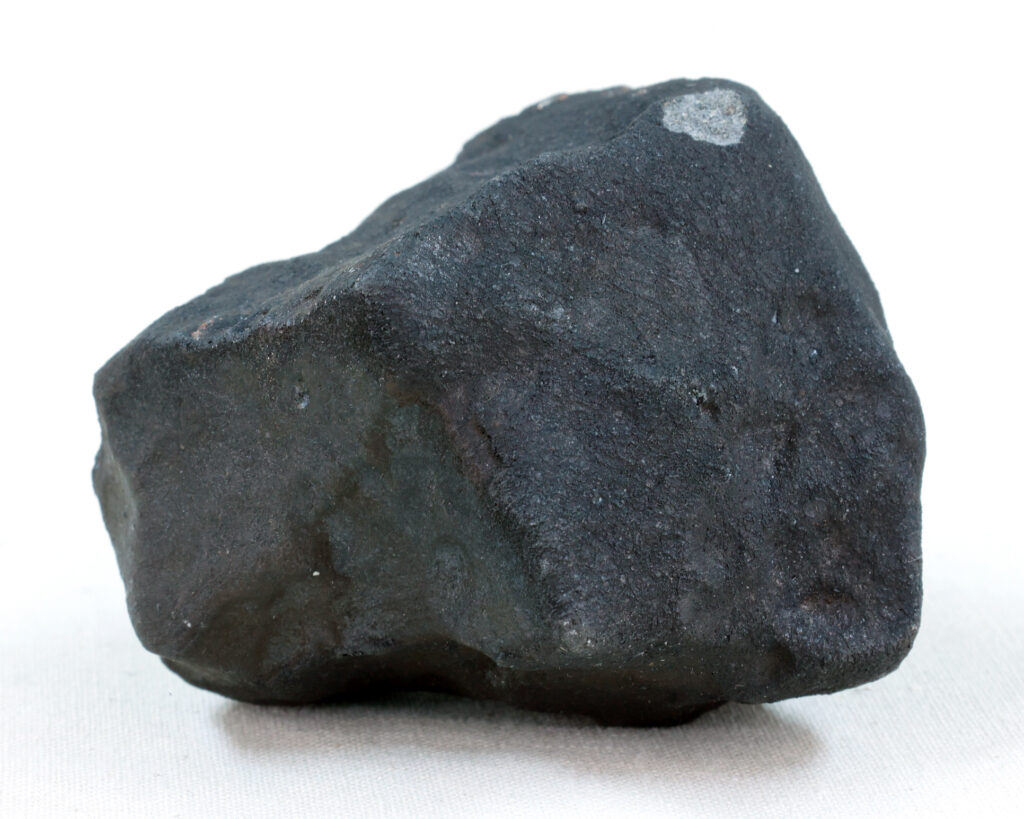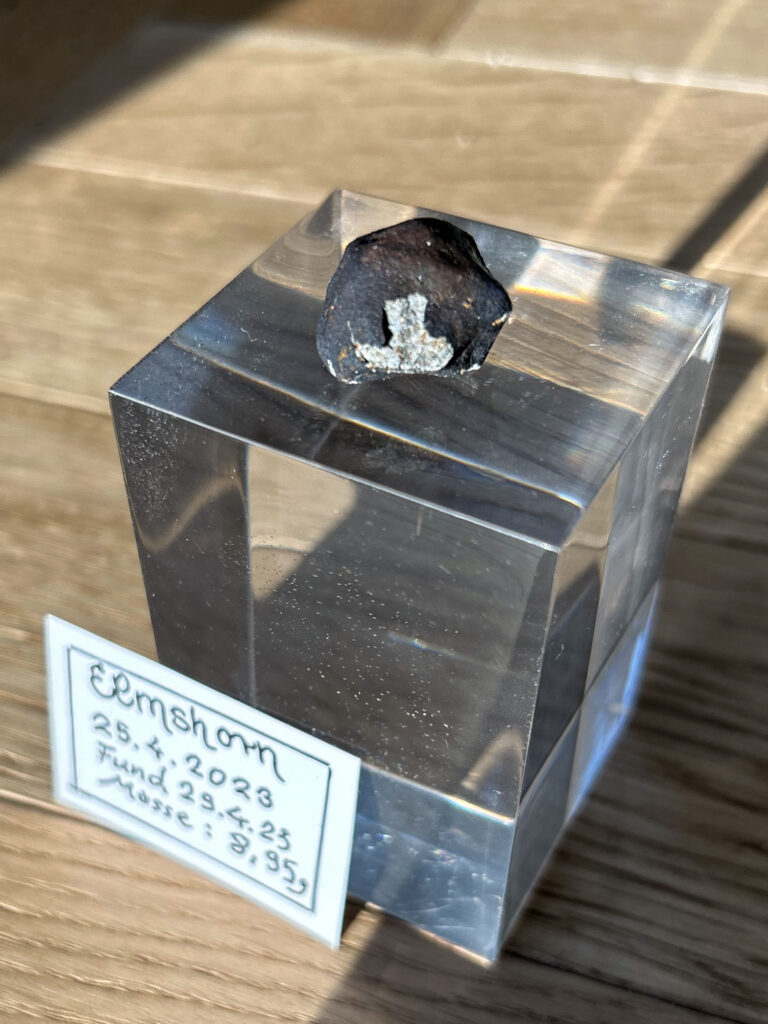ELMSHORN (H chondrite breccia) meteorite fall, (21 confirmed finds (incl. 3.736 kg, 233.4 g); ~4.271.4 kg TKW, H3-6) in Elmshorn, Pinneberg, Schleswig-Holstein, Germany, at 12:14:24 UT on 25 April 2023
Last update: 29 May 2024 (10:30 CEST)
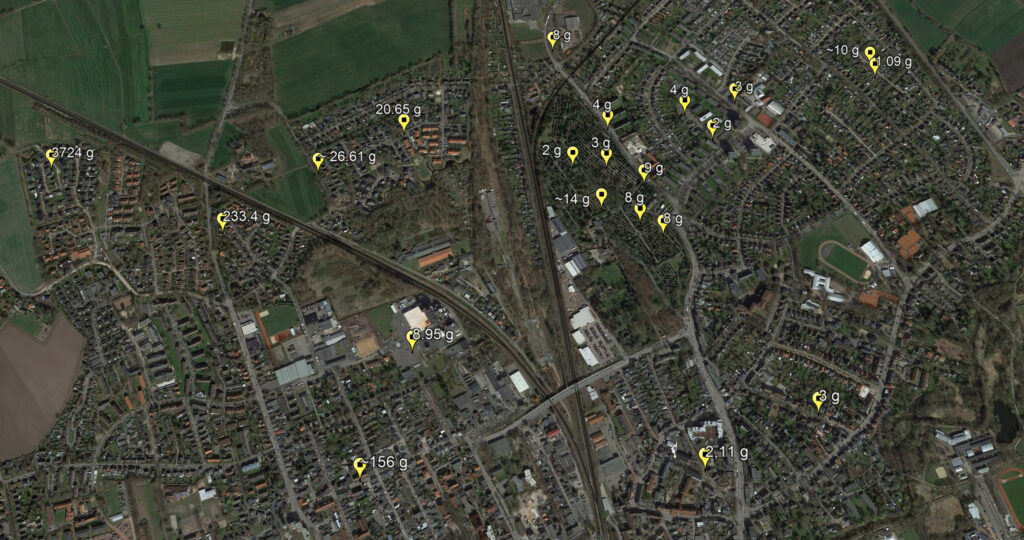
Currently known strewn field of the Elmshorn meteorite fall with exact and approximate find locations and weights of found masses. Image: karmaka
First find (3.736 kg)
On 26 April the Elmshorner Nachrichten reported that a ‘rock’ was found inside a ‘small crater’ (diameter of 15-20 cm, depth ~40 cm) in a garden of 47-year-old Mahmut Şahin’s house in Irena-Sendler-Straße (53°45’55.1″N, 9°38’04.3″E) in a residential area in the northwest of Elmshorn, Pinneberg, Schleswig-Holstein, Germany. Şahin’s wife Güllü and daughter Hatice were sitting in the living room having coffee when they heard the meteorite impacting the lawn in the garden. They went outside where they found the impact pit. The sound of the meteorite impacting the lawn (here probably digitally enhanced) was recorded by two surveillance cameras, one from a distance of about 18 metres. The video from the neighbour’s house recorded the sounds of the impact at the Şahins and their own frightened dog running from the garden into the neighbour’s house. The Şahins, initially thinking the hole had been caused by some kind of gas leak explosion or chemical reaction, called the hazmat truck of the Pinneberg fire fighting unit which dug out the meteorite and checked whether it was radioactive, which of course it wasn’t. Later Sahin’s daughter had the idea to ‘test the rock’ with one of her pinboard magnets. Like this the family knew that it was in fact a meteorite and the ‘rock’ in the garden turned out to be the biggest meteorite (brecciated H chondrite) of the Elmshorn fall so far, weighing 3.736 kilograms. Finder Şahin has sold the main mass to the Leibniz-Institut zur Analyse des Biodiversitätswandels (LIB) which was financially supported (€ 83300) by the Kulturstiftung der Länder. The mass will be permanently exhibited in the Museum der Natur in Hamburg from 27 April 2024. Before the meteorite was temporarily exhibited during the Munich Mineral Show (26-29 October 2023). The second largest fragment (233.5 grams) of Wilfried Labusch has been bought for an amount in the lower five-digit range by the Ministerium für Allgemeine und Berufliche Bildung, Wissenschaft, Forschung und Kultur of Schleswig-Holstein, the Kulturstiftung der Länder (€ 5500) and the Mathematisch-Naturwissenschaftlichen Fakultät of Christian-Albrechts-Universität Kiel and will be permanently exhibited together with the broken roof tiles at the Geologisches und Mineralogisches Museum of the Institut für Geowissenschaften at Christian-Albrechts-Universität in Kiel from 25 April 2024.
On 3 January 2024 the fall was officially registered in the MetBull database as ELMSHORN (H3-6, S2).
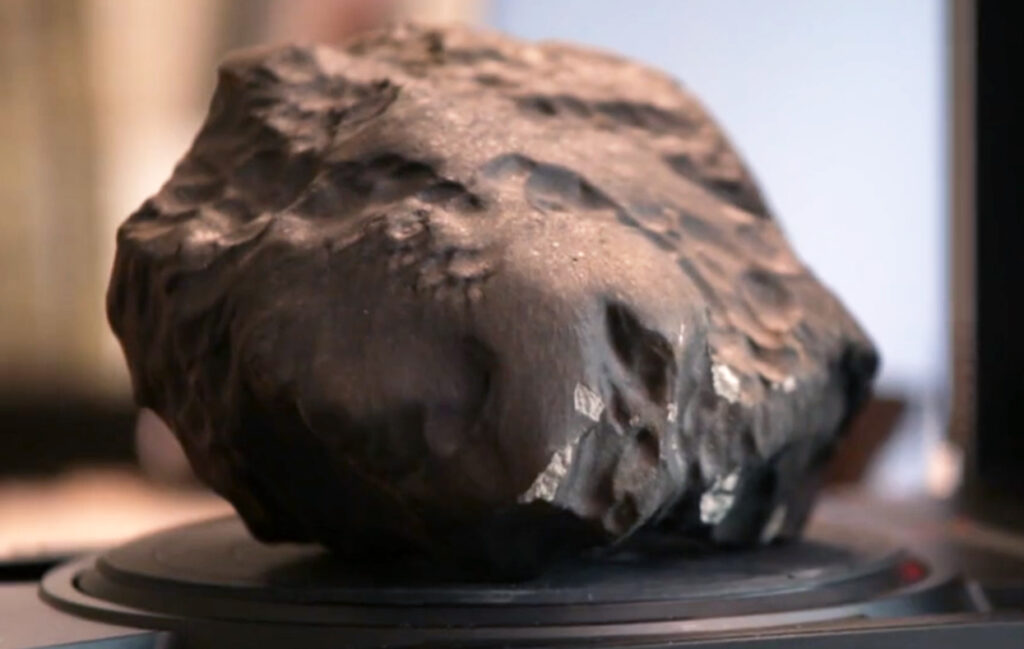
The almost fully fusion-crusted and regmaglypted meteorite while being 3D-scanned by Carsten Jonas. Image: NDR
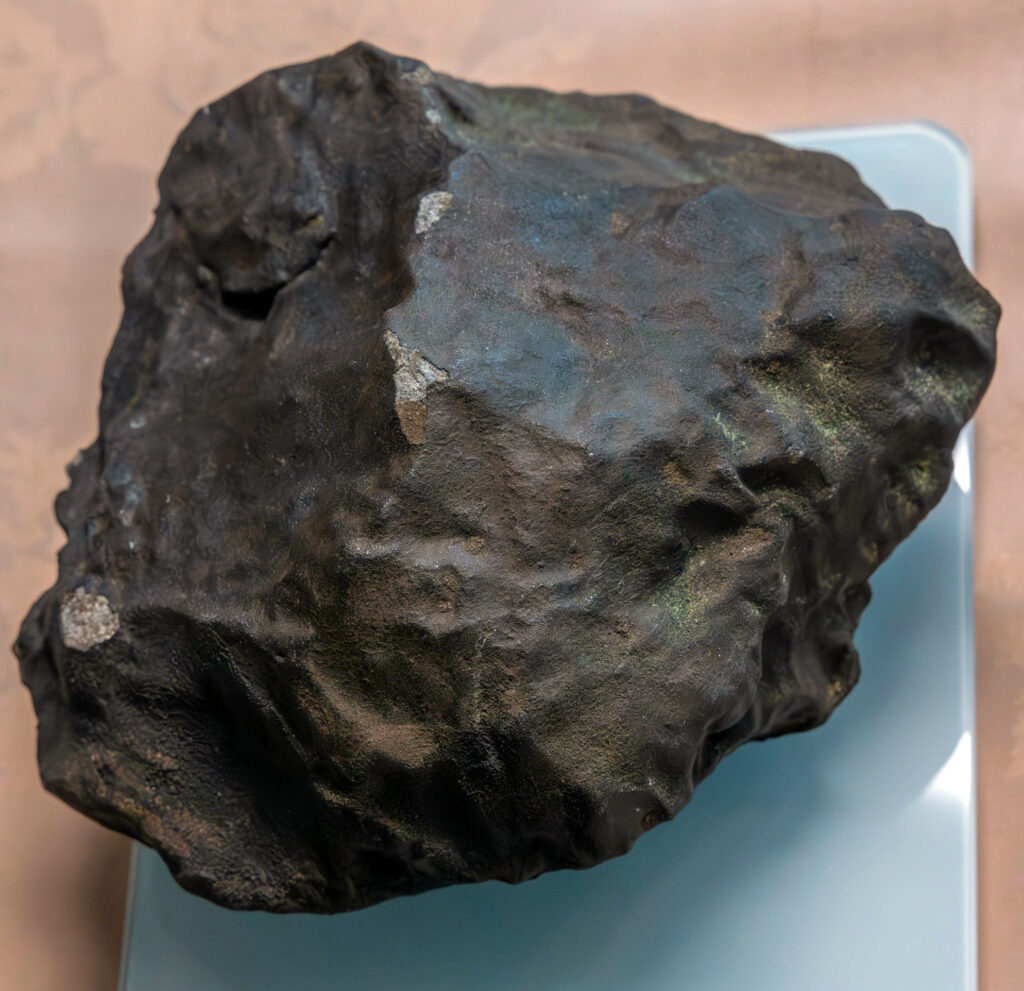
The almost fully fusion-crusted and regmaglypted 3736-gram mass being weighed. Photo: Carsten Jonas / Arbeitskreis Meteore
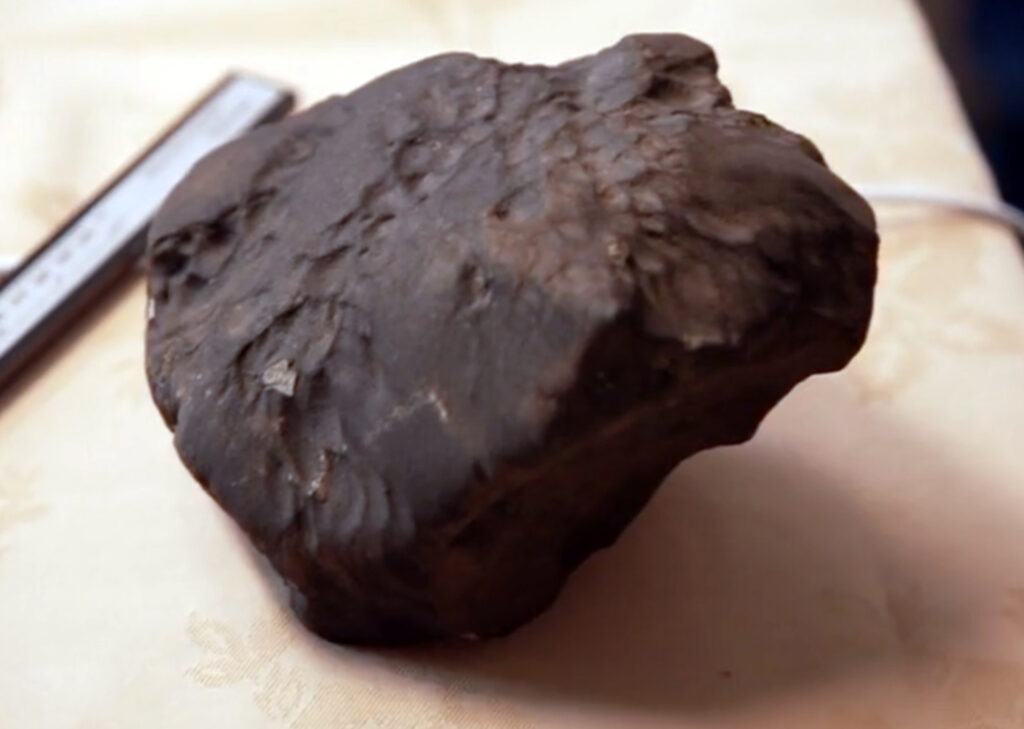
The regmaglypted leading side of the 3.7-kg mass. Image: NDR

The 3.7-kg mass. Image: NDR
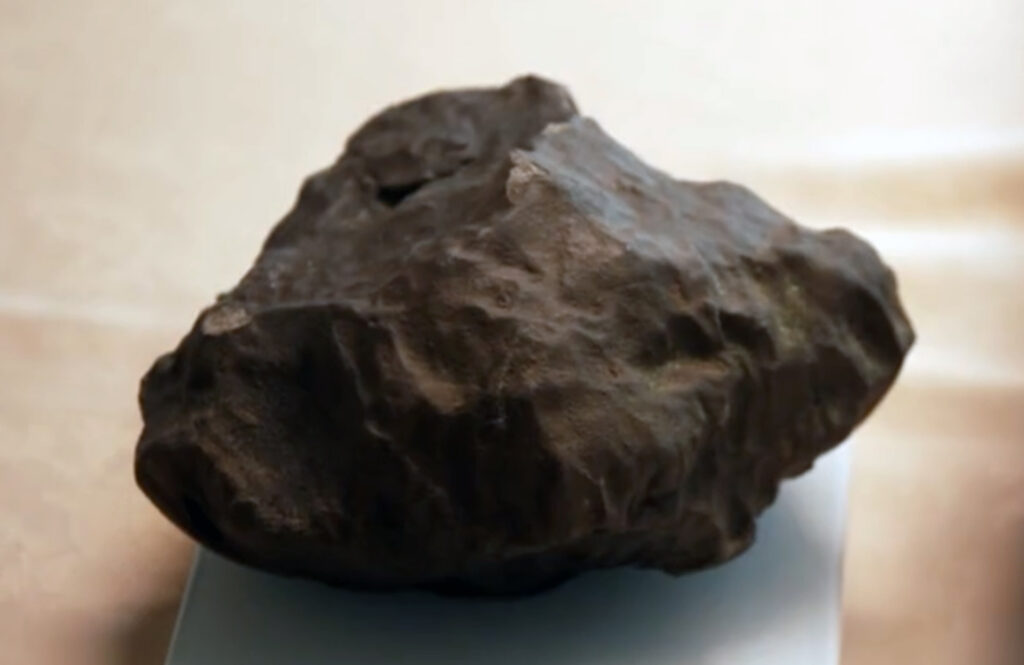
The 3.7-kg mass. Image: NDR

The 3.7-kg mass. Image: NDR
Blender rendering based on 3D scan data acquired by Carsten Jonas . The video was provided by Arbeitskreis Meteore e.V.
Blender rendering based on 3D scan data acquired by Carsten Jonas. The video was provided by Arbeitskreis Meteore e.V.
Irgendwie hab ich mich auch in den Stein ein bisschen verliebt.
(Mahmut Şahin )
(Somehow I have fallen a bit in love with this rock.)

The partly soil-covered 3.7-kilogram mass after it was removed from the impact pit. The soil-free leading side of the meteorite in the photo suggests that the mass entered the ground with its trailing side. Photo: Mahmut Şahin

The partly soil-covered 3.7-kilogram mass after it was removed from the impact pit. Photo: Mahmut Şahin

The cleaned 3.7-kilogram mass positioned on its refilled impact pit. Photo: Carsten Jonas, Arbeitskreis Meteore

The fresh impact hole of the 3.7-kilogram mass. Photo: Mahmut Şahin
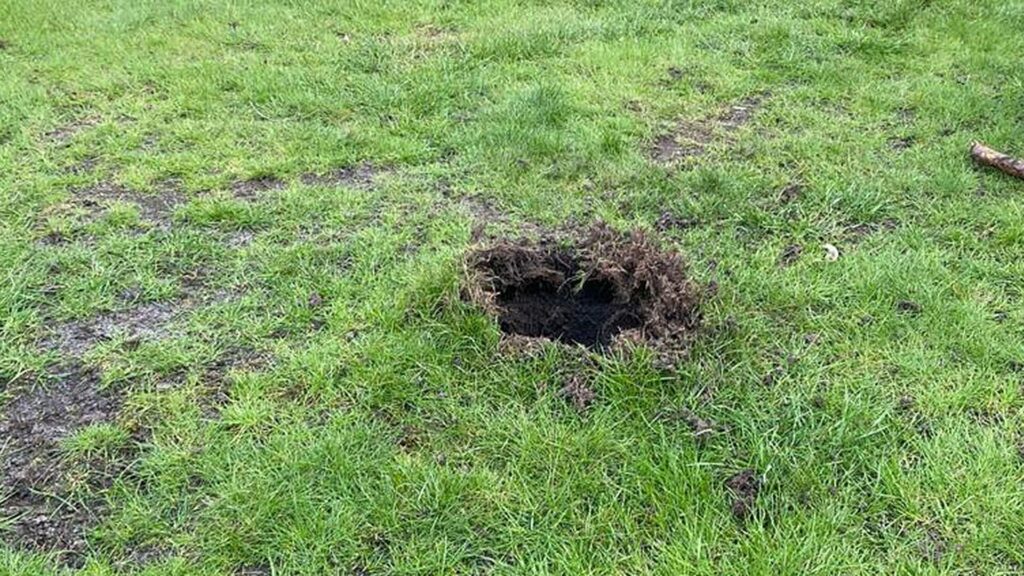
The fresh impact hole of the 3.7-kilogram mass. Photo: Mahmut Şahin

The location where the 3.7-kilogram mass hit the garden lawn. The impact pit (light patch in the lawn) has already been refilled. Image: NDR

The 3.7-kilogram Elmshorn main mass as exhibited at the Museum der Natur in Hamburg in April 2024. Photo: Leibniz-Institut zur Analyse des Biodiversitätswandels (LIB) / B. Pichelmann
Second find (233.4 g)
Having heard about this news story of a meteorite find in her immediate neighbourhood on 26 April Birgit Labusch (64), her husband Wilfried (74) and Marc Labusch from Elmshorn also decided to contact local media. Birgit Labusch phoned and reported that in the afternoon of the day before (25 April) a 233.4-gram meteorite (5 x 5.5 cm, H chondrite) had hit and damaged two overlapping roof tiles of their house above the entrance door at location 53°45’48.4″N, 9°38’33.3″E, about 570 metres east to southeast from the reported impact dent in the garden. On 25 April at 14.14 CEST Wilfried and Birgit were sitting in their living room when they suddenly heard a crashing sound, like a lightning strike, from their roof outside. They initially speculated a terra-cotta flower pot could have fallen from a window cill in front of the house. Wilfried immediately ran outside and saw the broken roof tiles which he initially described as ‘red rocks’. After a while of searching around the court in front of the house he found the meteorite in a gravel bed at the foot of a white metal fence which had been hit when the meteorite fell off the roof, leaving some minor scratches. Wilfried Labusch and his wife report that the meteorite was lukewarm for minutes after they touched it first. They put the meteorite in their living room. The couple used the magnet of a flashlight to check whether the meteorite was magnetic, which is a method which is not recommended because it changes the scientifically important paleomagnetic signature of the meteorite. On 27 April the Labusch family was phoned by Dieter Heinlein (Deutsches Zentrum für Luft- und Raumfahrt) who confirmed on visual inspection that their find was in fact a meteorite. When Labusch phoned a roofer to have the broken roof tiles replaced he initially refused to come because he thought Labusch was making an April fool of him. Eventually the tiles were replaced on 28 April. Photos of the regmaglypted ordinary chondrite with a fresh and almost intact fusion crust were first published in the Elmshorner Nachrichten on 27 April. On 28 or 29 April the Labusch mass was sent away for scientific analyses which include measuring short-lived radio isotopes with Gamma spectrometry for some weeks at VKTA’s Niederniveaumesslabor Felsenkeller in Dresden to determine for example the meteorite’s cosmic ray exposure age and its terrestrial age and thus also establish a definite connection to the recorded bolide event of 25 April. For the time being the 3.6-kilogram mass won’t be scientifically analysed.
“Erst haben wir einen Knall gehört und haben gedacht, ein Blitz hätte eingeschlagen. Und dann sind wir hier rausgerannt und haben geguckt. Und dann haben wir hier unten die Dachpfannen gesehen. Und dann haben wir erst gedacht, dass hier so’n Blumentopf aus Keramik, dass er da runtergeknallt ist. Und dann haben wir die Stücke aufgesammelt und hier raufgelegt. Und dann haben wir gesehen hier über’m Hauseingang, dass da ein großes Loch drin war. Und dann haben wir geguckt, hier das abgeguckt, und dann habe ich den Stein da an dieser Stelle am Zaun gefunden. Und er war noch leicht handwarm, sag ich mal so.”
Wilfried Labusch (28 April 2023)
( First we heard a bang and thought lightning had struck. And then we ran out here and looked. And then we saw the roof tiles down here. And then we thought at first that it was a ceramic flowerpot that had crashed down here. And then we picked up the pieces and put them up here. And then we saw here, above the entrance to the house, that there was a big hole in it. And then we looked and took a look here, and then I found the stone at this spot on the fence. And it was still slightly warm to the touch, I’d say. )
Third fragmented find (11 fragments, ~156 g)
Eleven meteorite fragments of a third find (~156 g) were found by a female homeowner on her driveway when she came back from a doctor’s appointment. The meteorite hit the red roof tiles of a house in the Gärtnerstraße in Elmshorn and fragmented into eleven pieces. One 38-gram fragment of the meteorite mass has been used for the classification of the Elmshorn meteorite by Dr. Markus Patzek and Prof. Dr. Addi Bischoff at the Institut für Planetologie at Münster University.
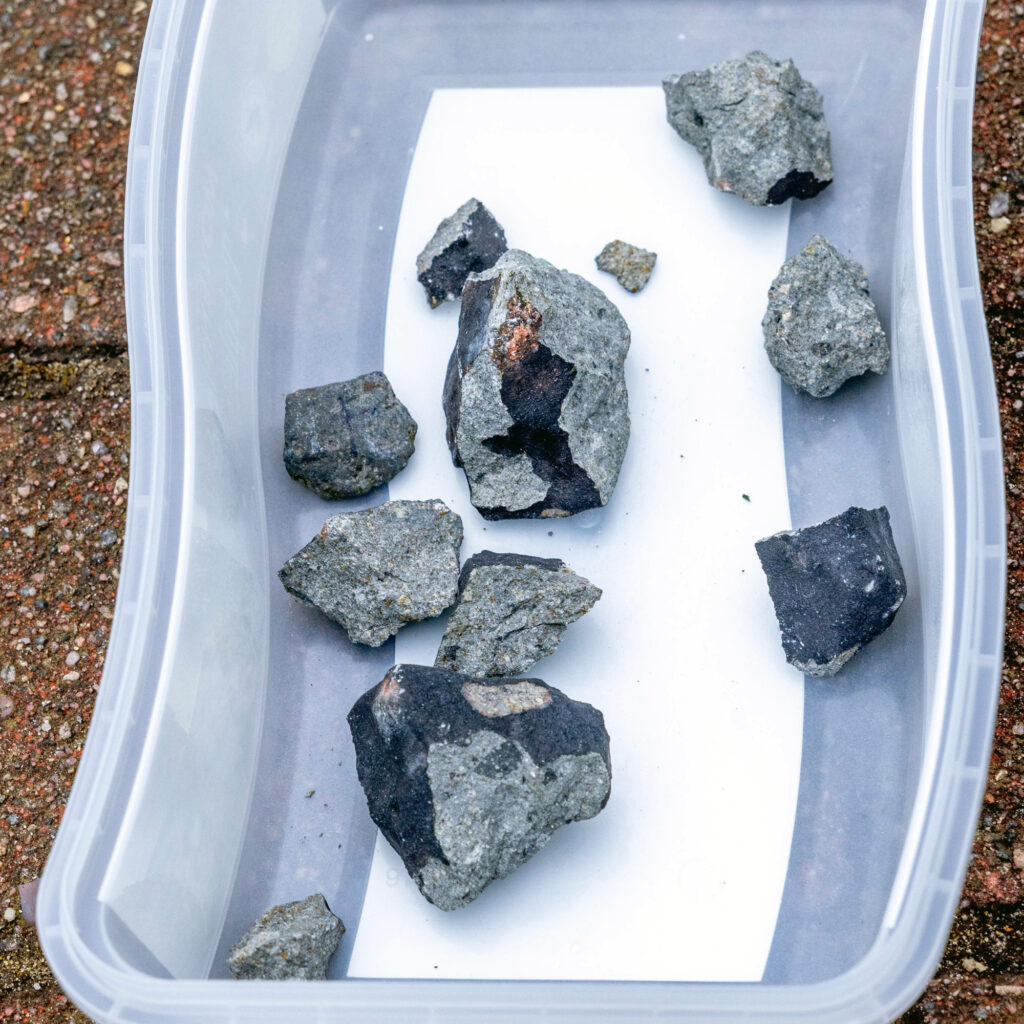
The eleven fragments of the mass which hit a roof in Gärtnerstraße. Photo: Carsten Jonas, Arbeitskreis Meteore
Additional finds (incl. 20.46 g, 9.15 g, 8.95 g, ~3 g, 2.11 g, 1.09 g )
On 29 April it was reported that more the 13 meteorite fragments with a total weight of more than 4 kilograms (masses of fragments and individuals between 160 g and 3.6 kg) have been found on private properties in Elmshorn. The current main mass seems to be the 3.6-kilogram individual. Three homeowners have reported their finds to the DLR. Apparently there are currently only 4 to 7 confirmed find locations. Several meteorite recovery groups from different countries are currently searching the area. On 29 April Maciek Burski inofficially reported he and Ewelina Burska had each found a meteorite fragment (20.46 and 9.15 grams) on a footpath and among grass in the street Kaltenhof somewhere near location 53°45’54.6″N, 9°38’47.7″E earlier that day. On 30 April Svend Buhl reports the find of a small intact specimen of 8.95 grams in a public area near location 53°45’36.8″N, 9°39’04.0″E in Elmshorn on that day. On 4 May the find of a 3-gram meteorite fragment in Moltkestraße in Elmshorn by a Polish searcher was inofficially announced. In the afternoon of 5 May Ingo Herkstroeter found an intact 2.11-gram specimen in a public area near location 53°45’26.4″N, 9°39’46.9″E in Fritz-Reuter-Straße. Łukasz Smuła and Magdalena Skirzewska report on their website that they’ve found 14 Elmshorn meteorites which together weigh 98.98 grams during their two-week search campaign starting on 1 May (including: 2.92g (near Moltkestraße), 20.65-gram (at roundabout along Ferdinand-Hanssen-Weg street), 7.98g in northern Elmshorn, four specimens (total 19.35g), and 7.98g). On 5 May a 1.09-gram specimen was found on the terrace of a house in Stettiner Straße by the home owner.
The 233.4-gram Labusch mass

The meteorite on display on top of the mailbox of the Labusch family’s house. The reddish colour reveals where the meteorite hit the surface of the roof tile. The greenish spot was probably caused by some moss on the impacted roof tiles. Photo: NDR (28 April 2023)
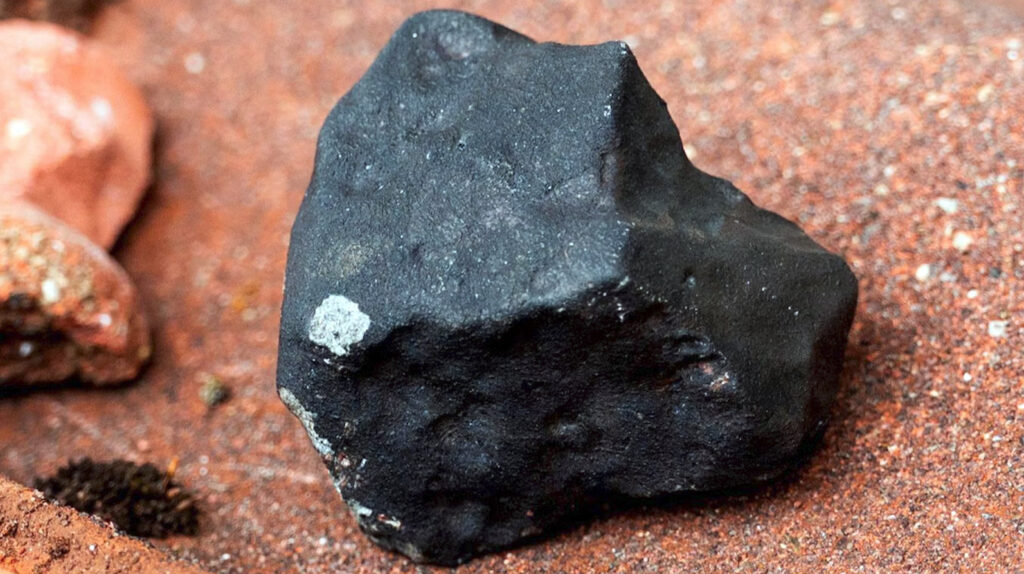
The meteorite on fragments of the impacted roof tile presented on a bench in front of the Wilfried Labusch’s house. Photo: dpa (28 April 2023)

Reenactment of the find position at the find location. Photo: NDR TV (28 April 2023)

Reenactment of the find position at the find location. Photo: NDR TV (28 April 2023)
Photo: SHZ (27 April 2023)
Photo: SHZ (27 April 2023)

Photo: SHZ (27 April 2023)
Photo: Daniel Bockwoldt/DPA (28 April 2023)
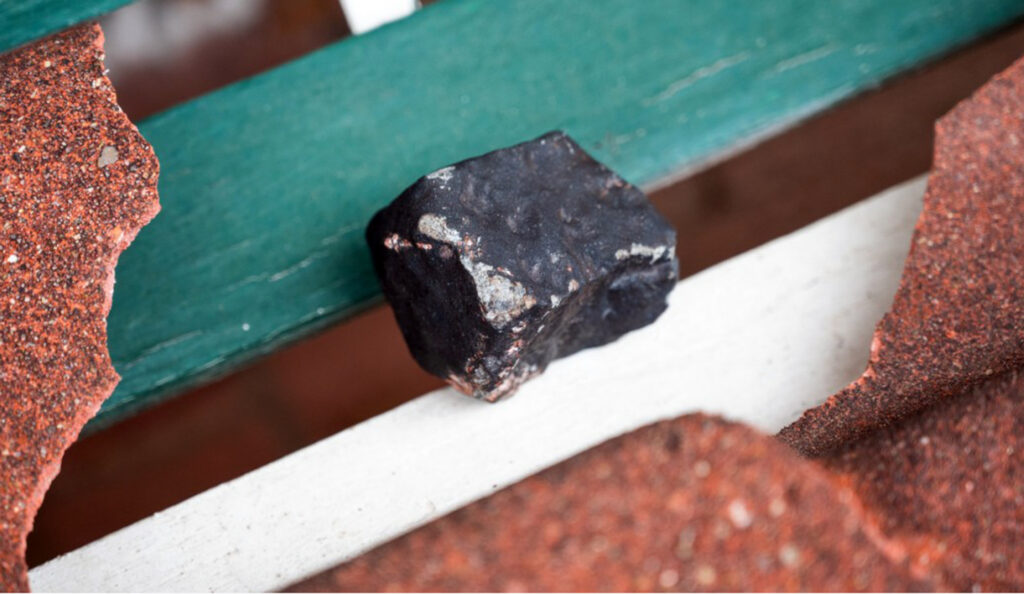
The meteorite next to fragments of the roof tiles on a wooden bench. Photo: Daniel Bockwoldt/DPA (28 April 2023)
The impact location on Labusch’s roof. The meteorite hit the overlapping part of two roof tiles damaging both of them partly. Photo: Wilfried Labusch, SHZ (27 April 2023)
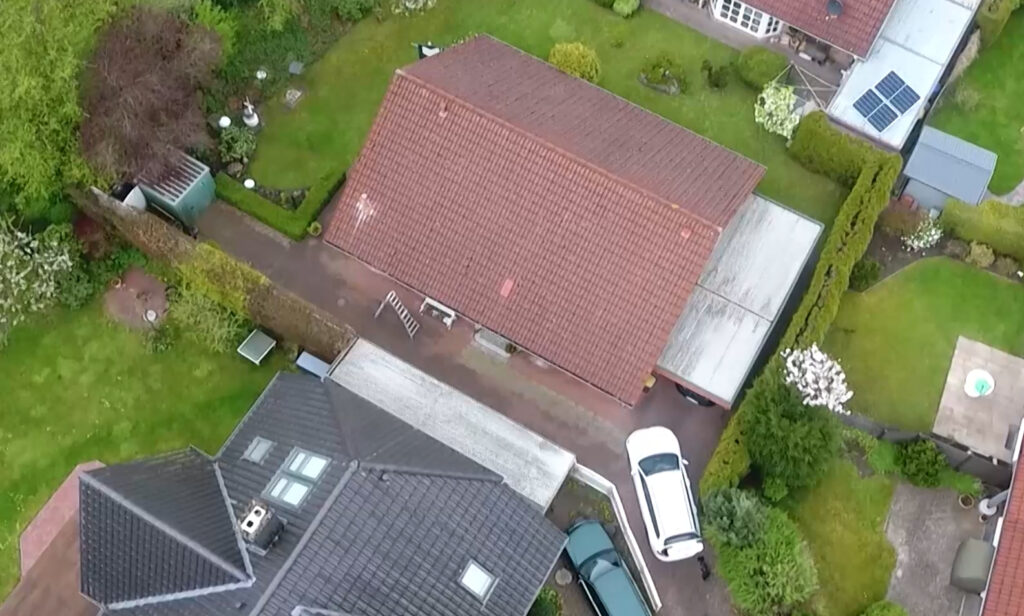
The impact location on the roof. The roof tiles have already been replaced. Photo: SHZ (28 April 2023)

The impact location on the roof above the entrance door. The broken roof tiles have been arranged on a bench. The roof tiles have already been replaced. Photo: SHZ (28 April 2023)

One of the scratches the meteorite left on the surface of the white metal fence after bouncing from the roof. Photo: WetterOnline
The 233.4-gram Labusch mass at Geologisches und Mineralogisches Museum of Christian-Albrechts-Universität in Kiel (CAU) in April 2024. Photos: Birgit Mohr/Universität Kiel
The 8.95-gram mass

The 8.95-gram mass in situ. Photo: Svend Buhl

The 8.95-gram mass in situ. Photo: Svend Buhl

S. Buhl with his 8.95-gram find on 30 April. Photo: Svend Buhl
The 8.95-gram Elmshorn mass. Photo: Svend Buhl
The 2.11-gram mass

The 2.11-gram mass at its find location on 5 May 2023. Photo: Ingo Herkstroeter
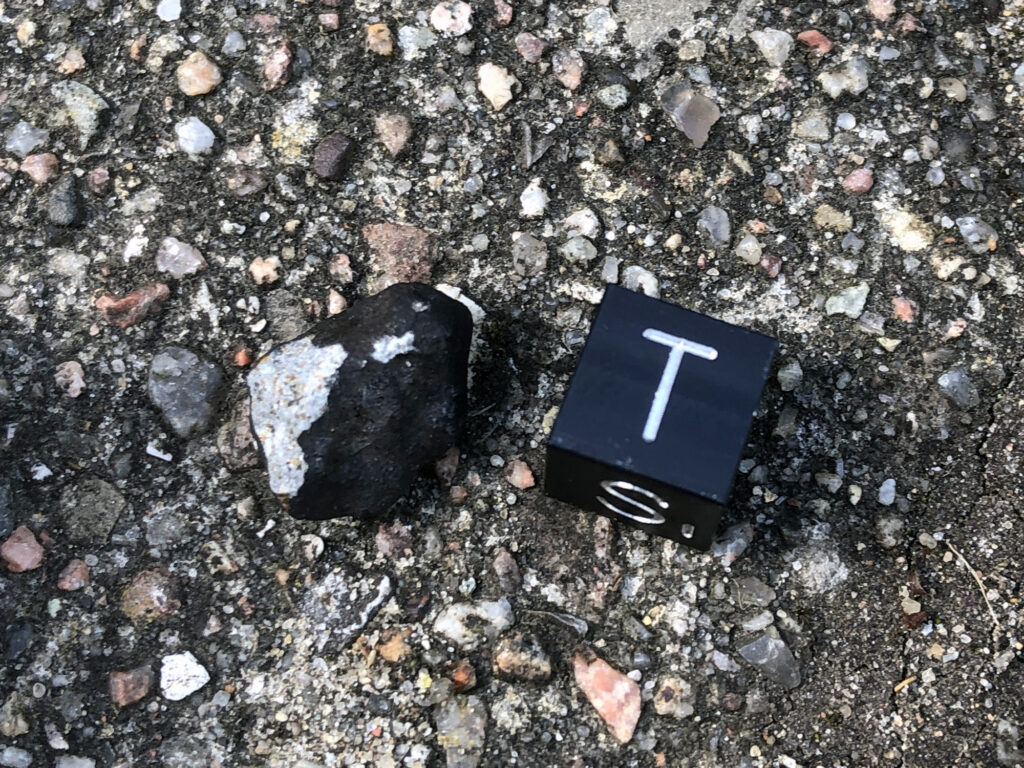
The 2.11-gram mass at its find location on 5 May 2023 . Photo: Ingo Herkstroeter
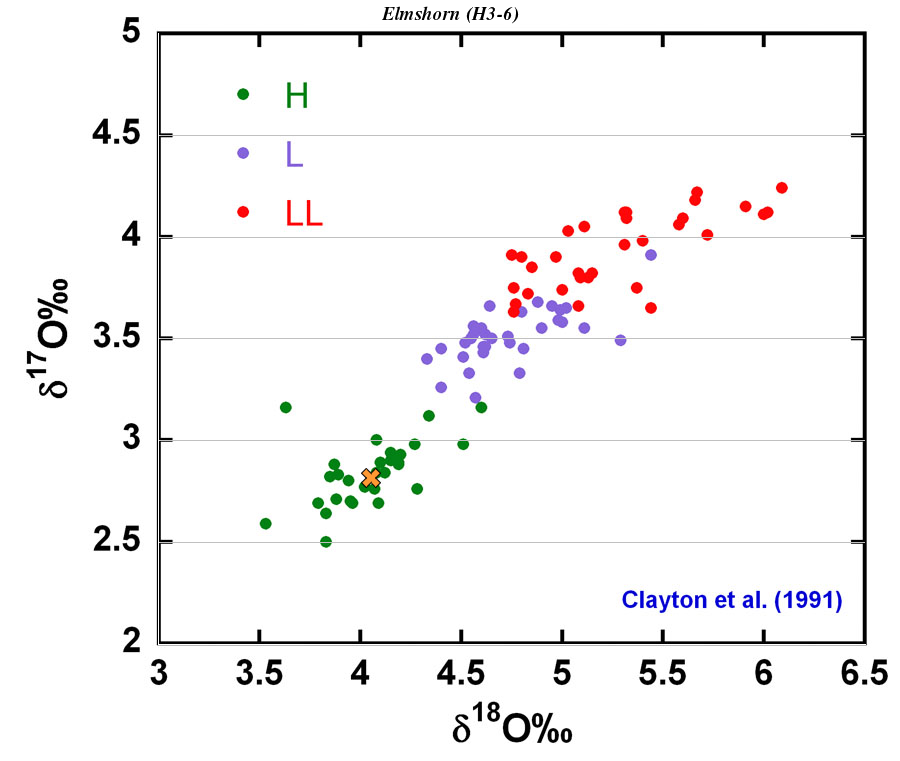
The anomalous polymict ordinary chondrite breccia of Elmshorn (H3-6)—Late reaccretion after collision between two ordinary chondrite parent bodies, complete disruption, and mixing possibly about 2.8 Gyr ago
Addi Bischoff, Markus Patzek, Romain M. L. Alosius, Jean-Alix Barrat, Jasper Berndt, Henner Busemann, Detlev Degering, Tommaso Di Rocco, Mattias Ek, Jérôme Gattacceca, Jose R. A. Godinho, Dieter Heinlein, Daniela Krietsch, Colin Maden, Oscar Marchhart, Martin Martschini, Silke Merchel, Andreas Pack, Stefan Peters, Miriam Rüfenacht, Jochen Schlüter, Maria Schönbächler, Aleksandra Stojic, Jakob Storz, Wolfgang Tillmann, Alexander Wieser, Karl Wimmer, Reiner Zielke
MAPS, Version of Record online: 29 May 2024
LINK (OPEN ACCESS)
PDF (OPEN ACCESS)
“Elmshorn fell April 25, 2023, about 30 km northwest of the city of Hamburg (Germany). Shortly after the fall, 21 pieces were recovered totaling a mass of 4277 g. Elmshorn is a polymict and anomalous H3-6 chondritic, fragmental breccia. The rock is a mixture of typical H chondrite lithologies and clasts of intermediate H/L (or L, based on magnetic properties) chondrite origin. In some of the 21 pieces, the H chondrite lithologies dominate, while in others the H/L (or L) chondrite components are prevalent. The H/L chondrite assignment of these components is based on the mean composition of their olivines in equilibrated type 4 fragments (~Fa21–22). The physical properties like density (3.34 g cm−3) and magnetic susceptibility (logχ <5.0, with χ in 10−9 m3 kg−1) are typical for L chondrites, which is inconsistent with the oxygen isotope compositions: all eight O isotope analyses from two different fragments clearly fall into the H chondrite field. Thus, the fragments found in the strewn field vary in mineralogy, mineral chemistry, and physical properties but not in O isotope characteristics. The sample most intensively studied belongs to the stones dominated by H chondrite lithologies. The chemical composition and nucleosynthetic Cr and Ti isotope data are typical for ordinary chondrites. The noble gases in Elmshorn represent a mixture between cosmogenic, radiogenic, and primordially trapped noble gases, while a solar wind component can be excluded. Because the chondritic rock of Elmshorn contains (a) H chondrite parent body interior materials (of types 5 and 6), (b) chondrite parent body near-surface materials (of types 3 and 4), (c) fragments of an H/L chondrite (dominant in many stones), (d) shock-darkened fragments, and (e) clasts of various types of impact melts but no solar wind-implanted noble gases, the different components cannot have been part of a parent body regolith. The most straightforward explanation is that the fragmental breccia of Elmshorn represents a reaccreted rock after a catastrophic collision between an H chondrite parent body and another body with H/L (or L) chondrite characteristics but with deviating O isotope values (i.e. that of H chondrites), complete disruption of the bodies, mixing, and reassembly. This is the only straightforward way that the implantation of solar wind gases could have been avoided in this kind of complex breccia. The gas retention ages of about 2.8 Gyr possibly indicate the closure time after the catastrophic collision between H and H/L (or L) chondrite parent bodies, while the cosmic ray exposure age for Elmshorn, which had a preatmospheric radius of 25–40 cm, is ~17–20 Myr.”
The bolide
Initial trajectory and darkflight calculations by Karl Wimmer yield that the bolide came in at a steep angle of about 80° which together with the effects of wind drift results in a very short triangular calculated fall zone length of about 2 kilometres for medium and larger masses which roughly covers the city area of Elmshorn which primarily contains private properties.
The AllSky7-camera stations in Bremerhaven (AMS62, Maciej Liebert, Jan-Gerd Mess/Sternfreunde Bremerhaven) and at Wolfsburg Planetarium (AMS213, Julia Lanz-Kröchert) recorded a part of the daytime bolide’s luminous trail.
The daytime bolide recorded from Bremerhaven, 74.8 kilometres west to west-southwest from the impact location on the roof. Video: Maciej Liebert, Jan-Gerd Mess

Stacked photo sequence of the luminous trail of the daytime bolide recorded from Bremerhaven, 74.8 kilometres west to west-southwest from the impact location on the roof. Photo: Maciej Liebert/Sternfreunde Bremerhaven
The daytime bolide (bottom right corner of video frame) recorded from Wolfsburg Planetarium, 167.9 kilometres south-southeast from the impact location on the roof. Video: Julia Lanz-Kröchert
MEDIA
Main mass being exhibited in Hamburg Museum (NDR TV, Hamburg Journal (25 April 2024, 19:30 CEST)
Meteorit wird in Dresden untersucht Interview with Detlef Degering (VKTA), MDR, Sachsenspiegel (9 June 2023)
Der Meteoritenfall von Elmshorn-Einschläge und Funde von Gesteins-Bruchstücken aus dem All
(DLR, 24 May 2023)
Erneut rekordverdächtiger Meteoritenfund in Elmshorn (Schleswig-Holstein Magazin, NDR SH, 19 May 2023, 19:00 CEST). At 0.09-0.10 minutes running time the original (!) impact sound of the meteorite on the lawn can be heard as it was recorded by a surveillance camera at a distance of about 18 metres from the impact location.
Meteorit trifft Haus in Elmshorn, NDR Info, 28 April 2023 17:00 CEST, Video: NDR
Meteorit schlägt in Einfamilienhaus in Elmshorn ein, Schleswig-Holstein Magazin, 28 April 2023, 19:30 CEST. Video: NDR
„Er war noch handwarm“ (Holsteiner Allgemeine, 2 May 2023)
Meteoriteneinschlag in Elmshorn: Bisher 13 Teile gefunden (Schleswig-Holstein Magazin, 29 April 2023, 14:40 CEST. Video: NDR)
Meteorit durchschlägt Hausdach in Schleswig-Holstein (Hit Radio FFH, 29 April 2023)
Meteorit schlägt in Elmshorn in Einfamilienhaus ein (Hamburger Abendblatt, 28 April 2023)
Meteorit schlägt ins Haus einer Familie aus Elmshorn ein (27 April 2023, 18:15 CEST)
Meteorit in Elmshorn eingeschlagen? Schwarzer Stein auf Radioaktivität untersucht (Elmshorner Nachrichten, first published: 26 April 2023, 14:10 CEST)

